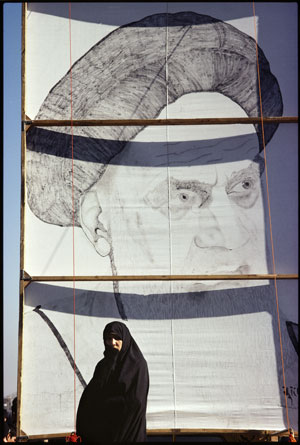Truly, the world has never been the same since. It was Burnett’s patience, and his willingness to go see for himself, that earned him the privileged position of being history’s witness. That same patience accounted for the 25-year wait before work on this book began in 2004. At that point, the editors had just published Red-Color News Soldier: A Chinese Photographer’s Odyssey Through the Cultural Revolution by Li Zhensheng, and it was a natural movement to progress from a revolution that ended in 1976 to another that began in 1978.
As in that previous volume, our intention was to present this body of work in the shape of a history book that joined the photographer’s images with text derived from his role as a personal observer to one of the most important and far-reaching events of the late 20th century. To achieve this, Burnett’s entire archive of contact sheets and color slides from Iran were meticulously organized, he himself submitted to dozens of hours of interviews, and substantial research was undertaken to verify his recollections and to craft the historical text sections in this book that give his images their proper context.
In many ways the revolution in Iran had a classic, nearly Shakespearian trajectory, and accordingly the book is structured along the lines of a three-act play: the last days of the shah, the interregnum, and the first days of Khomeini. Whereas many photographers were in Iran for one of these parts, Burnett was there for them all. These were the 44 Days of the title which, while making reference to the 444- day hostage crisis that began in November 1979, represent the turn of the screw: the fall of the monarchy and the establishment of an Islamic republic.
The photographs in this book—a significant representation, if only a fraction of Burnett’s total archive—were not chosen solely on aesthetic grounds, nor are they intended to be viewed as art. Rather they are remarkable historical documents, the contents of a time capsule from another era. To maintain their authenticity, they are presented entirely unmanipulated, with no conversions from color to black and white, never cropped, and sequenced, to the best of our ability, in their exact chronological order. There are gaps, to be sure, but such is the nature of the lone photojournalist’s work.
— Robert Pledge and Jacques Menasche
 |
| Awaiting Khomeini. Tehran, January 26, 1979 |
Book Data:
ISBN: 1426205139
ISBN-13: 9781426205132
Format: Hardcover 224 pages
Published By
National Geographic Society
September 29, 2009
Copyright © 2009 David Burnett
Represented by
Contact Press Images
Edited by Robert Pledge
and Jacque Menasche
Forward by
Christiane Amanpour
Introduction by
John Kifner